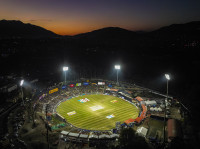Opinion
Sunshine and clouds
Many of the energy initiatives in the budget are achievable, but power production requires structural reforms
Bibek Raj Kandel
Since the government unveiled its annual budget of Rs1.05 trillion for the upcoming fiscal year 2016/2017, there have been fierce arguments on what the budget should have looked like. While some have criticised it as being inflationary, overly ambitious and a gross violation of fiscal discipline, others have applauded it as being timely, pro-poor and pro-development. There is one common theme running in the budget every year: The government that presents it continues to defend it and the people are invariably sceptical. Considering the history of opaque bureaucracies, real as well as perceived misconduct and incompetence of implementers, clumsy service delivery and widespread corruption in the budget implementing agencies, the scepticism will continue unless the government comes up with concrete plans to address these shortcomings.
Like all past budgets, this one too has some good, bad and ugly aspects. Let me pick a few of them here to advance discussion on what the new budget could mean for the energy sector and its development. Expediting ongoing hydropower projects, generating 10,000 MW of hydropower in the next decade, studying and identifying multipurpose projects, prioritising reservoir-based hydropower projects, expanding transmission lines, etc are some almost-unavoidable clichés in every budget without much tangible reforms in the needed areas. These are the plans every government expects people to believe. But most people do not. Yet, all of them are possible if the state is sufficiently willing.
Key breakthrough
The major takeaway for me from the new budget is the provision of a surcharge of Rs5 on each litre of petroleum import. I take this as a fundamental breakthrough, something that no government should postpone, although some experts are calling it a measure that could cause inflation. I have argued before in these pages that if the government wants to pump additional resources in its home-grown energy projects, there cannot be any better time than now to place an energy levy on petroleum imports when the international oil price is running low. Historical price trends indicate that the international oil price is not going to increase anytime soon even though it recently saw an 80 percent hike from its February low.
Even if the government had to make an upward adjustment to bring in such measures, which the current budget fortunately does not say, I would still have called that a smart move. If a portion of the revenue was also allocated in relatively smaller projects rather than in one single larger project with many social and technical issues still unresolved like the Budhigandaki Hydropower Project (1200 MW), it could have yielded some early results. Besides, a serious reform to make Nepal Oil Corporation (NOC) more transparent looks urgent to make this revenue generation mechanism more productive.
In terms of electricity
Talking of electricity market reform initiatives, the government has plans to unbundle the generation, transmission and distribution systems of its state-owned utility into separate legal entities. This is another encouraging mention in the budget. But since these reforms were also key items in the past budgets, speed of execution becomes more important here. The National Electricity Regulatory Commission (NERC), the independent entity envisioned a long time back that was anticipated to replace the Electricity Tariff Fixation Commission and create a level playing field for all the electricity sector stakeholders, is yet to be implemented. The government now plans to set up a mechanism with a team of experts to oversee and regulate these unbundled entities. In the absence of a strong authority, they could end up turning into another toothless state body. Thus, the establishment of a strong regulatory authority might be more appropriate for a politically volatile country like Nepal.
The push for 300MW solar projects in the new budget could make one curious to pay closer attention to the details. However, without a commitment of resources and plans on when and how the projects will be delivered, they look nothing more than cosmetic measures. Thus, this provision will likely have a fate of the 25 MW solar utility project mentioned in the 2071/72 budget. That project seems to have disappeared now, despite the promises of bringing it to the grid by March 2015. Sadly, these are a few ways how our governments are feeding public scepticism.
More than policies
The government has given high priority to renewables, as the new budget includes all the aforementioned strategies to expand all forms of clean energy technologies in off-grid rural communities or to subsidise urban consumers for solar adoption. With an 11 percent increase from the previous year’s budget of Rs5.49 billion, the planned spending of Rs6.1 billion however depends largely on the effective implementation of the Renewable Energy Subsidy Policy 2016, which the government approved last month. More than that, its success depends on how the effective delivery instruments are designed, supply chain bottlenecks overcome, targeted beneficiaries reached, possible subsidy leakages checked and prolonged differences among the various stakeholders bridged.
No doubt, the new budget signals a strong priority of the government to invest in the energy sector. And the initiatives are achievable, but energy production would require structural reforms and transformative governance to attract domestic and foreign investments in the sector. The government should be ready to free its institutions from the shackles of its notorious bureaucracy, as policies and targets would not deliver anything by themselves. Let us not get obsessed with the targets alone. With the country’s anticipated growth rate by the end of this fiscal year as low as 0.8 percent, most of our economic sectors are in shambles. There is little time to waste.
Kandel is a national advisor at Alternative Energy Promotion Centre; views expressed here are personal




 13.12°C Kathmandu
13.12°C Kathmandu










